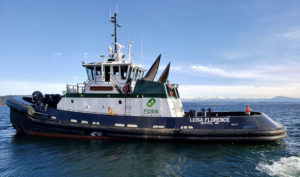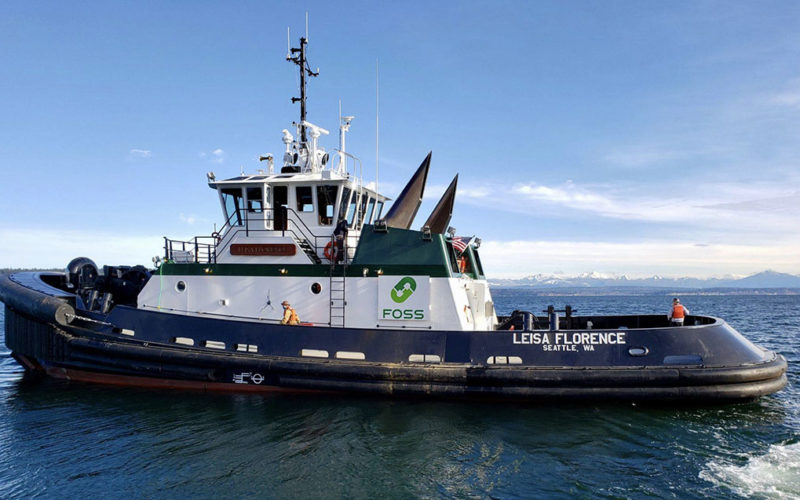
Foss Maritime Co. is nearly finished with a four-boat order from Nichols Brothers Boat Builders that has solidified its fleet of West Coast ship-assist tugboats.
The company’s 100-by-40-foot ASD-90 series consists of four Valor-class tugs designed by Jensen Maritime, now known as Crowley Engineering Services. The vessels carry the same proven legacy as other Valor-class workhorses, but with cleaner-burning Tier 4 engines and a host of other upgrades.
The lead boats in Foss’ ASD-90 series, Jamie Ann and Sarah Avrick, are working in San Francisco Bay escorting and docking tankers and other large ships.
Leisa Florence left the Freeland, Wash., shipyard early this year and is a modified ASD-90 class tugboat. It shares the same 6,866-hp MTU power plant delivering 92 tons of bollard pull ahead and 90 astern, and the same robust Markey hawser winch. The primary difference is the deck gear installed on the aft deck.
Dan Cole, Foss’ project manager for the ASD-90 class, said the lead two tugs were outfitted for ship assist and near-shore rescue towing. To that end, these vessels have a double-drum Markey TESS-34AS winch on the stern that can hold 2,600 feet of 2.25-inch wire, along with robust Smith Berger Marine towing pins.
“The addition of this stern winch allows for additional opportunities to use our tugs, in particular rescue towing work when a ship near the U.S. West Coast experiences malfunction and needs to be towed,” Cole said of the winch arrangement on Jamie Ann and Sarah Avrick. “As a result, Foss has additional flexibility to manage how they dispatch vessels, so at least one rescue towing-capable tug is available in any port we operate in.”
Leisa Florence and its sister tug, Rachael Allen – scheduled for delivery in late spring 2021 – eschew the double-drum winch for a smaller Markey DEPC—32 barge-handling winch. The towing pins have been replaced by a sturdy staple on the aft deck. The arrangement is well suited for towing a barge off the hip and other instances where it helps to have two lines out, Cole said.
Otherwise, Leisa Florence is virtually identical to the lead two tugboats. In that sense, it is outfitted to safely and efficiently escort some of the largest ships calling on the West Coast. Leisa also joins a growing number of 90-ton bollard pull tugboats built within the last five years.
Valor-class tugboats, used by multiple West Coast operators, are known for high horsepower, impressive bollard pull ratings and robust skegs under the keel. Foss built on these characteristics for the ASD-90 series and upgraded the design by enlarging the fuel tanks to 72,000 gallons for operational flexibility.
The spacious, high-ceilinged engine room is a prevailing feature of the Valor-class tugboats. Leisa Florence and its sister tugs in the series put that space to good use with two 3,433-hp MTU Series 4000 engines paired with aftertreatment from selective catalytic reduction (SCR) units. Those mains are coupled with Kongsberg z-drives through a Vulkan carbon-fiber shaft.
Tier 4 can be achieved in several ways. One option is exhaust gas recirculation (EGR), which is used in GE Tier 4 engines. Long-haul ocean tugs have operating profiles that often make EGR a better fit.
The SCR units installed on the four ASD-90 Foss tugs achieve the Tier 4 rating by injecting urea into the exhaust and catalyst filters to clean the emissions. Nitrogen oxides (NOx), an air pollutant, are created by fuel combustion at high temperatures – and the hotter the temperature, the greater the production of NOx. The urea and catalysts break up the NOx and convert it to nitrogen and water vapor. Reducing particulate matter and NOx are essential to achieving Tier 4 emissions standards.
Electrical power while underway comes from three generators installed forward of the main engines. Two 120-kW Bollard gensets are the primary power plants. For periods when lower electrical loads are required, including when the tug is tied up, Foss installed a 65-kW Bollard harbor generator from MER Equipment that is inside a noise-mitigating enclosure.
“You can be in the engine room and talk to one another without shouting to be heard while the generator is running,” Robert Allen, CEO of MER Equipment, said last year of the enclosed harbor genset installed on Jamie Ann.
Hiller supplied the FM-200 fire suppression system installed in the engine room. Firefighting equipment consists of a 100-hp Flowserve fire pump and forward-mounted Stang 2.5-inch monitor that can dispense 900 gallons per minute.
The ASD-90 class incorporates other changes from the classic Valor-class tugs. Rescue doors, for instance, were built into the bulwarks to assist with man-overboard recovery. Noise and vibration from the engine compartment are reduced by a thick application of mineral insulation. The SCR units, while paired to the MTU main engines for emissions purposes, have an added benefit of dampening engine noise.
The interior spaces on Leisa Florence mirror those on the preceding ASD-90 tugboats, as well as the forthcoming Rachael Allen. The main deck has the galley and mess, a full head and two staterooms. Two other staterooms are located below deck, forward of the engine room. The vessel has accommodations for eight people, but normal operations require four crewmembers.
The wheelhouse follows the industry standard of placing the helm chair between the port and starboard z-drive controls. Foss installed Furuno radars and AIS systems, Rose Point Navigation software and a Simrad autopilot system. Icom VHF radios and an Iridium satellite communications system are standard across the ASD-90 series.
Sea Machines in May announced Foss installed its SM300 autonomous command-and-control system aboard Rachael Allen. It is the first application of the SM300 system on a tugboat with more than 5,000 hp, according to Sea Machines.
The SM300 system is capable of autonomous transits and remote access to the tugboat’s onboard machinery, Sea Machines said in a news release. The system also has navigation obstacle detection and avoidance capabilities. Foss will incorporate the technology in phases over six to nine months.
“Foss is leveraging Sea Machines’ cutting-edge technology to take on the routine work and allow crew to focus on higher-level tasks and improve safety, while also increasing productivity and efficiency,” Will Roberts, Foss president and CEO, said in the release.
Markey supplied the DEPC-32 barge-handling winch on the stern, and the single-drum DEPGF-52R electric winch installed at the bow. The bow hawser is spooled with 525 feet of 9-inch Cortland Plasma line.
Foss, part of the Saltchuk family of tugboat companies, has long operated one of the sturdiest and most versatile tug fleets on the West Coast. Earlier this year, Saltchuk added additional capabilities with the acquisition of eight Centerline Logistics ship-assist tugboats operating under the Starlight and Millenium brands in California. Saltchuk consolidated those vessels under the Starlight name, which continues to crew and dispatch its own tugs. Foss sold its California bunkering assets to Centerline as part of the deal.
Leisa Florence has primarily operated in the ports of Los Angeles and Long Beach. Rachael Allen work in San Francisco or Los Angeles after leaving the shipyard, adding to Foss’ existing capabilities in those busy California ports.

